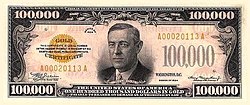This article needs to be updated.(September 2019) |

Several presidents of the United States have appeared on currency. The president of the United States has appeared on official banknotes, coins for circulation, and commemorative coins in the United States, the Confederate States of America, the Philippine Islands, the Commonwealth of the Philippines and around the world.
Contents
- United States
- George Washington
- John Adams
- Thomas Jefferson
- James Madison
- James Monroe
- John Quincy Adams
- Andrew Jackson
- Martin Van Buren
- William H. Harrison
- John Tyler
- James K. Polk
- Zachary Taylor
- Millard Fillmore
- Franklin Pierce
- James Buchanan
- Abraham Lincoln
- Andrew Johnson
- Ulysses S. Grant
- Rutherford B. Hayes
- James A. Garfield
- Chester A. Arthur
- Grover Cleveland
- Benjamin Harrison
- William McKinley
- Theodore Roosevelt
- William Howard Taft
- Woodrow Wilson
- Warren G. Harding
- Calvin Coolidge
- Herbert Hoover
- Franklin D. Roosevelt
- Harry S. Truman
- Dwight D. Eisenhower
- John F. Kennedy
- Lyndon B. Johnson
- Richard Nixon
- Gerald Ford
- Ronald Reagan
- George H. W. Bush
- Presidential dollar coin series
- Confederate States of America
- Andrew Jackson 2
- George Washington 2
- Philippine Islands, Commonwealth of the Philippines, Republic of the Philippines
- William McKinley 2
- Ronald Reagan 2
- Franklin D. Roosevelt 2
- George Washington 3
- U.S. presidential appearances on other coins and currency around the world
- The Bahamas
- Cook Islands
- Cuba
- Isle of Man
- Liberia
- Marshall Islands
- Niue
- Paraguay
- Turks and Caicos Islands
- United Arab Emirates
- Western Samoa
- See also
- References
- Bibliography
- External links

































